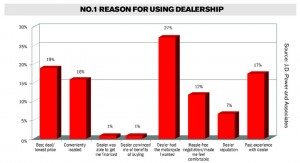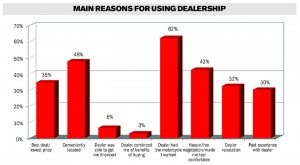Factors other than price drive customers to dealerships
Buyers seek in-stock bikes before hunting for a deal
With 48 years in the motorcycle industry and 16 years as a Harley dealer, Big Moose Harley-Davidson in Portland, Maine, knows how to serve and retain customers.
As the economy has dipped, principal Steve Reynolds has seen more price shoppers coming into his store, but he also knows discounting isn’t always necessary to attract a buyer.
“I think people, because of the economy, are shopping harder than they’ve ever shopped, but people still want to go to a store where they’re treated fair and they’re treated like family,” he said. “We at Big Moose Harley-Davidson would like to believe that people would pay a little more here because of the way that they’re treated.”
Some dealers who are feeling the pressure from price-conscious shoppers may think Reynolds is alone is his thinking, but the 2011 J.D. Power and Associates Motorcycle Competitive Info Study shows price isn’t always the No. 1 reason a customer chooses a dealership for a purchase. In fact, only 19 percent of new bike buyers said the best deal or lowest price brought them into their selling dealership. It ranked second on the list of eight options.
The top choice for the No. 1 reason for choosing a dealership, as chosen by 27 percent of respondents, was actually that the dealer had the motorcycle the rider wanted in stock.

Michael Macecsko of The Dealer Team says dealers should use this information to improve their stock.
“Listen to [the] customers — what bikes do they want? Stop buying the bikes that the manager wants to go on the floor,” he said.
Many dealers stock what they think will be popular and look to sell the bikes that yield the most profit or that have been on the floor too long. Macecsko suggests dealers instead look to their customers for ideas, creating focus groups of a variety of customers within a range demographics and then carrying what they ask for.
“They need to get in contact with their customers and ask them to their face, ‘What do you want?’” Macecsko said.
Despite the popularity of model selection, price shoppers are still prevalent. Macecsko says that group can be appeased and catered to in some ways, but dealers should be careful how they handle stock and negotiating to prevent becoming a discount-centric business, like many used car dealerships.
“I’m not a fan of degrading your product,” he said.
Macecsko recommends that dealers be reasonable with negotiations and consider their options, especially with non-current models.
“I’ve watched dealers lose money on a deal. Because it’s in cost average, they don’t actually lose any money on that bike,” he said. “Every day that it sits on their floor, they have to pay the flooring for it.”
But he doesn’t recommending selling on discount or negotiating on every deal. If a dealer, for example, is comfortable selling 250 motorcycles per year at MSRP and is capable of doing so, he should.
“Don’t make price become an issue is what dealers should not do,” he said.
Instead of focusing on how to please cost-cutting customers, dealerships should be concerned about serving their customers, which in effect, will hopefully encourage them to pay a little more than if they received poor service.
“I’m not a fan of discounting; I’m a fan of more bang for the buck,” Macecsko said.
With 17 percent of respondents seeking a dealer primarily because of past experiences in the store and 7 percent drawn in foremost by dealer reputation, paying attention to customers’ needs and wants is crucial.

“Service, service, service — and I’m not talking about fixing the motorcycle or replacing the oil. Provide service to the customer; do what you would want them to do for you,” Macecsko advised.
By providing added value to a purchase or experience, dealers can recruit new customers or encourage former customers to return. And despite location, which is the No. 1 reason for buying at a dealer for 16 percent of riders, they can still gather a following.
“It’s all about the customer,” Macecsko said. “If the customer isn’t having fun, if the customer’s not happy, he’s going to go somewhere else.”
A few services he recommends include filling up the gas tank of each bike sold, providing roadside assistance, offering loaner motorcycles to service customers, staying open later or on different days, or even cleaning customers’ laundry. Many dealers are also helping customers by picking up and dropping off service bikes at customers’ homes or places of work, and some that are in states where Blue Laws apply spend Sundays, when they can’t sell bikes, picking up service jobs.
“Do what you say; say what you mean; go the extra mile,” Macecsko said. “Earn the business without saying to someone, ‘Let me earn your business’ because it’s so cheesy. Be willing to go 110 percent; be willing to go the extra mile.”
Reynolds has learned in his family’s decades of experience that serving customers in a manner that is warming and helpful can be key to continuing sales.
“You don’t stay a motorcycle dealer that long by not treating people right,” he said, “so we definitely believe in treating the customer like you’d want to be treated yourself.”






I could not agree more!
If we have learned anything from being in business since 1958 We have learned SERVICE starts at the front door not the shop door.
We also are a family business and treat every customer as such FAMILY.
ASK POWERSPORTS
central Ohio